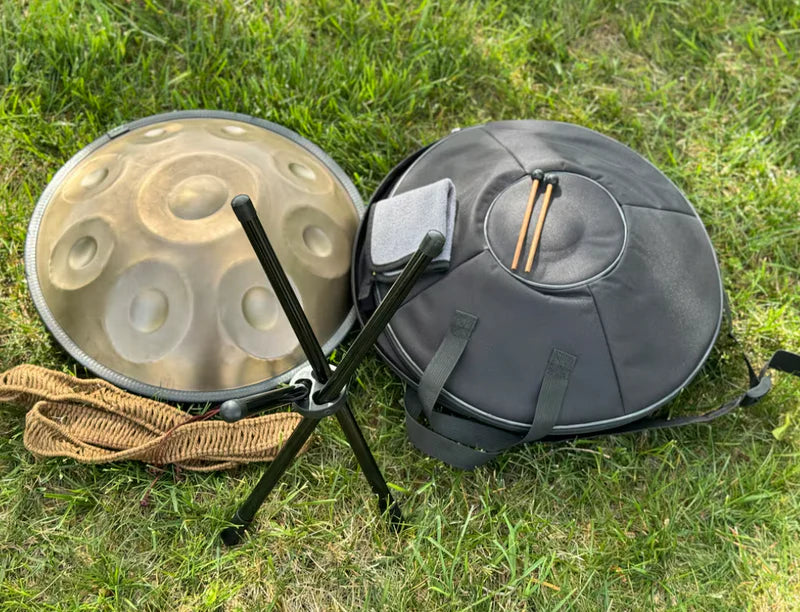Singing bowl tones and frequencies offer a profound exploration into the vibrational impact of sound on our well-being.
These ancient instruments, often made from quartz crystal, produce distinct tones and frequencies that correspond to various aspects of physical, emotional, and spiritual health.
By understanding how each tone interacts with the body's energy centers or chakras, individuals can harness the power of these harmonious vibrations for healing and meditation.
Delving into the specific frequencies of singing bowls reveals their ultimate potential to enhance personal growth and restore balance.
Also Read: Sound Healing Daily Practice Benefits: 5 Benefits
Singing Bowl Tones and Frequencies

Singing bowls, also known as Tibetan or Himalayan singing bowls, are fascinating instruments often used in meditation, sound therapy, and spiritual practices. They produce rich, resonant tones that can vary widely depending on their size, shape, and material. Here’s a brief overview of their tones and frequencies:
Tones and Frequencies
Basic Tones:
Singing bowls typically produce a fundamental tone along with a series of overtones or harmonics. The fundamental tone is the lowest and most dominant frequency, while the overtones are higher frequencies that give the bowl its unique sound.
Frequency Range:
The fundamental frequencies of singing bowls usually range from about 100 Hz to 500 Hz. Larger bowls generally produce lower frequencies, while smaller bowls produce higher frequencies. For example:
- Small bowls: Often produce frequencies between 200 Hz and 500 Hz.
- Medium bowls: Typically range from 100 Hz to 300 Hz.
- Large bowls: Can produce frequencies as low as 100 Hz or even below, depending on their size.
Harmonics:
Each bowl has a complex overtone structure. These overtones can be more subtle and vary greatly between different bowls. The harmonic series can include frequencies that are integer multiples of the fundamental tone.
- Musical Notes: Some singing bowls are tuned to specific musical notes or scales, which can align with traditional systems like the Solfeggio frequencies or modern Western scales. Common notes might include:
- C, D, E, F, G, A, B: Often related to the notes of the Western musical scale.
- Solfeggio Frequencies: Specific frequencies like 396 Hz, 528 Hz, etc., are believed to have various healing properties.
Applications:
- Meditation and Relaxation: The resonant tones can help induce relaxation, focus, and a meditative state.
- Sound Healing: The frequencies are used in therapeutic settings to promote healing and balance the body's energy.
- Chakra Balancing: Some practitioners use bowls tuned to specific notes associated with different chakras.
Also Read: How To Reduce Your Stress Using Crystal Bowl Sound Healing (Step-By- Step Guide)
What Is Crystal Singing Bowl Resonance and Harmony?

Crystal Singing Bowl Resonance:
Crystal singing bowl resonance is the bowl's ability to produce and sustain clear, pure frequencies through vibration. Made of quartz, it creates prolonged, harmonious tones that enhance meditation and sound healing by providing a continuous, calming auditory experience.
Crystal Singing Bowl Harmony:
Crystal singing bowl harmony refers to the balanced relationship between the bowl’s fundamental tone and its overtones, producing a rich, layered sound. This harmonious frequency alignment supports relaxation and healing by creating a soothing and resonant auditory experience.
What Is Crystal Singing Bowl Frequency?

Crystal singing bowl frequency is the specific pitch or vibration produced by the bowl when struck or played. These frequencies, often tuned to precise notes or healing frequencies, can range from 100 Hz to 500 Hz or more. Each bowl’s frequency corresponds to different aspects of physical and emotional healing, aligning with chakra energies or specific therapeutic purposes.
Crystal Singing Bowl Frequency Chart
A Crystal Singing Bowl Frequency Chart typically lists the frequencies and corresponding notes that different bowls are tuned to. Here’s a general guide to some common frequencies and their associated notes or chakras:
| Frequency (Hz) | Note | Chakra |
|---|
| 256 | C | Root Chakra |
| 285 | C# | Sacral Chakra |
| 396 | D | Solar Plexus Chakra |
| 417 | D# | Heart Chakra |
| 528 | E | Throat Chakra |
| 639 | F | Third Eye Chakra |
| 741 | F# | Crown Chakra |
| 852 | G | Higher Self/Spirit |
| 963 | G# | Universal Connection |
Note:
Are Crystal Singing Bowls Really Effective?
Crystal singing bowls are widely valued for their calming and meditative effects, with many users reporting benefits like deep relaxation and enhanced focus.
They are believed to aid in balancing energy and supporting emotional and physical healing, though scientific evidence is limited. Effectiveness often depends on individual experiences and beliefs.
How Does Crystal Singing Bowls Produce Sound?
Crystal singing bowls produce sound through vibration created when struck or rubbed with a mallet. Made from quartz crystal, these bowls are precisely crafted to vibrate at specific frequencies.
When the bowl is struck or circled with a mallet, the friction generates sound waves that cause the bowl to resonate. This resonance produces a clear, pure tone that can be sustained for a prolonged period due to the bowl's material properties.
The vibrations travel through the air and can also be felt physically, creating a soothing auditory experience. The frequencies produced are often tuned to align with specific musical notes or healing frequencies.
Types Of Crystal Singing Bowls?
Crystal singing bowls come in various types, each with distinct characteristics:
Clear Quartz Bowls: Made from pure quartz, they produce a clear, resonant tone. Commonly used for general meditation and healing.
Frosted Quartz Bowls: These have a matte, frosted finish and offer a warmer, softer sound. They are often preferred for their gentle, soothing qualities.
Colored Quartz Bowls: Infused with minerals to create colors, these bowls may have unique tonal qualities and are often used for specific healing practices associated with their color.
Alchemical Bowls: Crafted with a blend of metals and minerals, they produce complex, rich tones and are used for advanced sound therapy and deeper healing work.
Gong Bowls: Shaped like gongs, these bowls produce a deep, resonant sound, often used for grounding and powerful sound healing sessions.
What Is Crystal Singing Bowl Frequency?
Crystal singing bowl frequency refers to the specific pitch or vibration produced by the bowl when struck or played. These frequencies are determined by the bowl's size, shape, and material.
Crystal singing bowls are often tuned to precise notes or healing frequencies, which can range from around 100 Hz to 500 Hz or more.
Each frequency is believed to correspond to different aspects of physical and emotional healing or align with specific chakras, making the bowls useful in meditation and sound therapy.
Does Crystal Singing Bowls Produce Different Sounds?
Yes, crystal singing bowls produce different sounds based on their size, shape, material, and frequency. Each bowl generates a unique tone and set of overtones when played, creating a range of sounds from deep and resonant to high and clear.
Variations in design, such as clear versus frosted quartz or colored quartz, also influence the quality and character of the sound produced. These differences allow for a diverse auditory experience and cater to specific meditation or healing needs.
Also Check: Which Crystal Singing Bowl Should I Start With?
Conclusion
Singing bowl tones and frequencies play a crucial role in their effectiveness for meditation and healing. Each bowl's unique frequency and resonant properties offer distinct auditory experiences, from deep, grounding tones to high, clarifying sounds.
Understanding the relationship between these tones and their associated frequencies helps in selecting the right bowl for specific practices. Ultimately, the diverse range of sounds produced by singing bowls enhances their ability to support relaxation, balance, and overall well-being.





Leave a comment
This site is protected by hCaptcha and the hCaptcha Privacy Policy and Terms of Service apply.